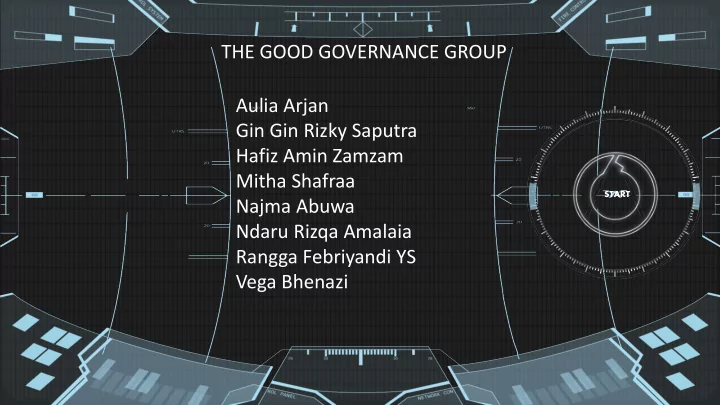

THE GOOD GOVERNANCE GROUP Aulia Arjan Gin Gin Rizky Saputra Hafiz Amin Zamzam Mitha Shafraa START Najma Abuwa Ndaru Rizqa Amalaia Rangga Febriyandi YS Vega Bhenazi
Material ELEMENTS DEFINITION EXIT HISTORY EXAMPLE MATERIAL
> Definition of good governance in general DEFINITION > Based on World bank > Based on IMF NEXT > Based on our perspective
why do we need good governance? DEFINITION the problems that getting complex and can not solved. people can not trust the government BACK
ANCIENT ERA HIS ISTORY MEDIEVAL ERA EARLY ERA BACK MODERN ERA
ANCIENT ERA • Ancient greek (1200 BC- 146BC) • Ancient rome ( 753 BC – 476 AD) NEXT
Ancient greek (1200 BC- 146BC) ANCIENT ERA • Ancient greek have a lot of different types of government, change over time • In mycenean period (1200BC) all greek city states were monarchies and ruled by kings • In archaic period (800BC) greek government domination by the oligarchic (ruled by rich man) • On 510 BC Athena creates the first democratic government, and since that, the other city-states try to imitates the democratic. NEXT
Ancient Rome ( 753 BC – 476 AD ) ANCIENT ERA • in its earliest days, was governed by kings. However, Ancient Rome was to develop its own form of government that allowed the Romans to govern themselves. • By the time roman change to the democratic system to reduce the slavery and the violence. • From 509-27 BC rome was governed as a republic. NEXT
Medieval era use feudalism system for governing MEDIEVAL Feudalism consist of 3 classes : Noble, Peasantry, and Clergy ERA Nobility (Those who fight) : consist of knights and aristocracies. Nobles protect the land as knight and/or study to become monks. Clergy (Those who pray) : Consist of churchmen: Bishops, Priests, Monks and Nuns. Clergy is the one who keep people to be religious and happy. Peasantry : consist of common people, Slaves, Serf, and Tradesman. They are working for upper class and has no rights. But, granted with protection from the knights. NEXT
Structure of the feudalism governance is relation between the king, the MEDIEVAL vassal, and the peasant. ERA The king owned all land and have absolute power. The Vassals (Baron) is people who granted its own land by king. And rule the land, or print their own money. They must pay the tax to the king, follow king’s order and serve the knights. The peasant is the lowest class, they are major population and they must serve under the king or the vassal. They are oppressed and have no rights. NEXT
• Islam kingdom in Indonesia (13-16 century) EARLY • Renaissance in Europe (14-16 century) MODERN • Elizabeth period in United Kingdom (1558-1603) ERA • Keshokugan Tokugawa in Japan (1603-1868) • Mughal empire in India (1526-1857) • Ottoman empire in Turkey (1299-1912) • Qing Dinasty in China (1644-1912) • Spain Empire in America (16 century- 1820’s) in Europe (16 -17 Century) and in Philippines (1525-1898) NEXT
• The Ottoman state rested on a principle of absolute authority in the monarch. The nature of Ottoman is autocracy. EARLY • The central function of the ruler or Sultan in Ottoman political theory was to guarantee justice in the land. All authority hinges on the ruler's personal MODERN commitment to justice. ERA • The Ottomans set up a number of practices and institutions in the central government surrounding the Sultan: a. The first was the establishment of a bureaucracy drawn from the Sultan's inner circle. b. Observance of government c. Siyaset (Politics) NEXT d. Public declaration of laws and taxes e. Accessibility f. Public opinion
Modern on 21 st century MODERN • Now days most of the governmental systems in the wolrd are ERA democracies • But the problems in this era is neo-liberalism • The appearance of corporations • The decrease in participation and rule of law function NEXT
EIG IGHT ELEMENT OF GOOD ELEMENTS GOVERNANCE RULE OF RESPONSIVENESS TRANSSPARANCY LAW CONSENSUS PARTICIPATION ORIENTED EFFECTIVENESS EQUITY AND AND ACCOUNTABILITY INCLUSIVNESS EFFICIENCY
TOWARD IMPROVED GOVERNANCE Good governance is an ideal which is difficult to achieve in its totality. Governance typically involves well-intentioned people who bring their ideas, experiences, preferences and other human strengths and shortcomings to the policy- making table. Good governance is achieved through an on- going discourse that attempts to capture all of the considerations involved in assuring that stakeholder interests are addressed and reflected in policy initiatives. BACK
Example of Singapore • Establish some forums who involve society with government to discussion • Singapore Financial Reporting Standard (SFRS) has follow International Financial Reporting Standard • Publish the case result as detail in believable and provide website about the result, new policy and news • Government has joined with the International Organizations of BACK Security Commissions (IOSCO) • Minority shareholders can not nominate independent directors
LOG OUT YES NO
Recommend
More recommend